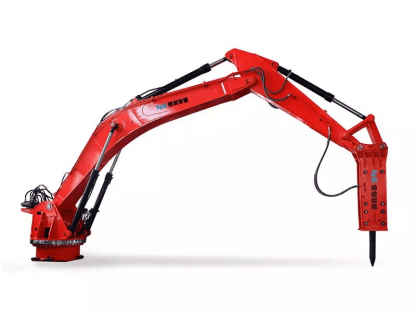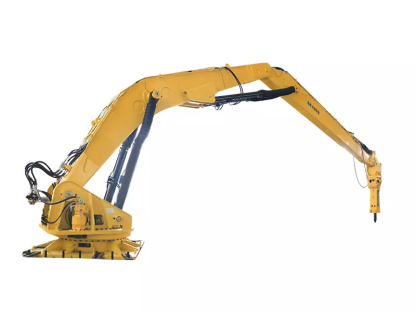II. Understanding Rockbreakers
VI. Industry-Specific Applications
In construction, mining, and demolition industries, Rockbreakers and excavators are indispensable. However, their roles and functionalities are often conflated. While a Rockbreaker is a specialized tool designed to fracture hard surfaces like rock and concrete, an excavator is a versatile machine primarily used for digging and material handling. This article clarifies their differences, explores overlapping applications, and highlights industry-specific use cases to help professionals choose the right equipment.


A Rockbreaker (or Rock Breaker Machine) is a hydraulic or robotic device engineered to break hard materials such as rock, concrete, or asphalt. These systems deliver high-impact force through a Rock Breaker Boom, making them essential in mining, quarrying, and demolition. Terms like Rock Breaker Systems or Breaker Booms refer to their structural and operational configurations.
Stationary Rock Breaker:
Permanently installed at sites like mines or crusher stations. Ideal for continuous operation in primary crushing stages.
Mobile Boom Systems:
Mounted on carriers (e.g., trucks or excavators) for flexibility in construction or roadwork.
Pedestal Rock Breaker Boom System:
Fixed to structures (e.g., processing plants) for precise material breakdown.
Rock Breaker Boom: The arm that positions the breaker tool.
Hydraulic Power Unit: Generates force for impact.
Robotic Breaker: Advanced models use automation for precision and safety.
Excavators are heavy-duty machines designed for digging, lifting, and earthmoving. Their versatility stems from interchangeable attachments, such as buckets, grapples, or rock breaker excavator tools.
Attachments: Can switch between a bucket, hydraulic hammer, or robotic concrete breaker.
Mobility: Self-propelled on tracks or wheels, unlike stationary systems like the pedestal rock breaker boom system.
| Aspect | Rockbreaker | Excavator |
|---|---|---|
| Primary Role | Breaking hard materials | Digging, lifting, material handling |
| Specialization | Single-task focus (e.g., rock breaker mining) | Multi-functional with attachments |
| Mobility | Often stationary (e.g., stationary rock breaker) | Highly mobile |
Rockbreaker: Integrated with a Rockbreaker Boom System for targeted impact.
Excavator: Features a hydraulic arm adaptable to multiple tools.
Mining: Rock Breaker Systems clear blockages in crushers; excavators transport ore.
Demolition: Robotic concrete breaker ensures precision; excavators handle debris.
Robotic Breaker: AI-enhanced systems reduce human intervention in hazardous zones.
Hybrid setups, such as mobile boom systems mounted on excavators, merge mobility with specialized breaking power. For example, a rock breaker excavator combines digging and breaking functions, ideal for urban demolition.
Rockbreaker Boom System: Clears oversized rocks at primary crushers.
Excavator: Extracts and loads mined material.
Robotic Breaker: Safely demolishes high-rise structures.
Excavator: Prepares sites with grading and trenching.
Stationary Rock Breaker: Processes aggregate at fixed points.
Mobile Boom Systems: Breaks boulders in remote quarry sections.
| Factor | Rockbreaker | Excavator |
|---|---|---|
| Project Scale | Large, continuous operations (e.g., mines) | Smaller, versatile tasks |
| Material Hardness | Extremely hard surfaces (e.g., granite) | Soil, loose rubble |
| Budget | Higher initial cost | Lower cost with attachment flexibility |
Automation: Robotic breaker systems with AI optimize impact frequency and force.
Sustainability: Electric-powered Rock Breaker Machines reduce carbon footprints.
While Rockbreakers excel in precision breaking of tough materials, excavators offer unmatched versatility. The rise of robotic concrete breaker technology and hybrid systems underscores the industry’s shift toward efficiency and safety. Understanding their distinct roles ensures optimal machinery selection.
1. Can an excavator replace a Rockbreaker?
Yes, if fitted with a rock breaker excavator attachment. However, dedicated Rock Breaker Systems outperform in high-intensity tasks.
2. What’s the advantage of a pedestal rock breaker boom system?
It offers stability and precision for continuous operations, such as in crusher stations.
3. Are robotic breakers safer than traditional methods?
Yes. Robotic breaker systems minimize human exposure to hazardous environments.
4. Which is more cost-effective for small projects?
Excavators with attachments are budget-friendly due to their multi-functionality.
5. How do I maintain a Rock Breaker Boom?
Regularly inspect hydraulic lines, lubricate joints, and replace worn breaker tips.